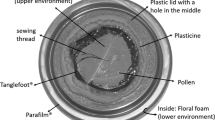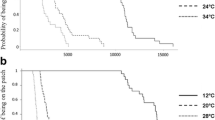Abstract
We investigated the influence of temperature and resources on six morphological characters thought to distinguish two North American species of Hemisarcoptes (H. malus and H. cooremani). We raised mites at three temperatures (15, 24 or 30°C) and on two different scale insect prey (Aspidiotus nerii or Aonidiella aurantii) which were cultured on two different substrates (potato tubers and lemon fruit). In general, the temperature had more of an influence on the character variation than did the host and the highest temperature resulted in the smallest mean body size. The two species did not respond to changes in the temperature or host in a symmetrical fashion. The temperature significantly influenced the lengths of the external scapular setae (sce) of H. malus and the sce and first coxal setae (1a) of H. cooremani. The relative lengths of the setae sce and 1a of H. cooremani were significantly influenced by the temperature, while the host type significantly influenced the paraproctal setae (ps 2). Major-axis regressions indicated that H. cooremani had an absolutely longer mean setal length for 1a and for ps 2, than H. malus, but a relatively shorter sce. An ANOVA of the size-adjusted shield characters of H. malus resulted in non-significant effects of the temperature or host on either the prodorsal shield area or and area in H. cooremani. Regressions of the shield area (size) on body length, resulted in two clear groupings by species. Hemisarcoptes cooremani had an absolutely larger shield area and increased circumference (complexity), as compared to H. malus. A plot of the shield circumference in relation to the shield area, however, resulted in a single trajectory, indicating that shield complexity is an allometric consequence of an increase in body size in both species. Though characters can be influenced significantly by environmental parameters, the species-specific patterns of some characters of North American Hemisarcoptes are distinctive enough to allow diagnosis and identification.
Similar content being viewed by others
References
Borchsenius, N. S. 1966. A Catalogue of the Armoured Scale Insects (Diaspididae) of the World. Academy of Sciences of USSR, Zoology Institute, Moscow and Leningrad.
Gerson, U. and Capua, S. 1982. Allometric variation in Rhizoglyphus robini Claparede (Acari: Astigmata: Acaridae). Israel J. Entomol. 16: 69–72.
Gerson, U., OConnor, B. M. and Houck, M. A. 1990. Acari. In Armored scale insects, their biology, natural enemies and control, Vol. B, D., Rosen (ed.), pp. 77–97. Elsevier Science Publishers, Amsterdam.
Griffiths, D. A. 1970. A further systematic study of the genus Acarus L., 1758 (Acaridae, Acarina), with key to species. Bull. Br. Mus. (Nat. History) Zool. 19: 85–118.
Griffiths, D. A., Atyeo, W. T., Norton, R. A. and Lynch, C. A. 1990. The idiosomal chaetotaxy of astigmatid mites. J. Zool. (London) 220: 1–32.
Harvey, P. K. 1981. A simple algorithm for the unique characterization of convex polygons. Comput. Geosci. 7: 387–392.
Houck, M. A. and OConnor, B. M. 1990. Ontogeny and life history of Hemisarcoptes cooremani (Acari: Hemisarcoptidae). Ann. Entomol. Soc. Am. 83: 161–205.
OConnor, B. M. and Reisen, W. 1978. Chiroptoglyphus, a new genus of mites associated with bats with comments on the family Rosensteiniidae (Acari: Astigmata). Int. J. Acarol. 4: 179–194.
SAS Institute 1982. User's Guide: Statistics. SAS Institute, Cary, NC.
Shimer, H. 1868. Notes on the ‘Apple bark-louse’ (Lepidosaphes conchiformis, Gmelin sp.) with a description of a supposed new Acarus. Trans. Am. Entomol. Soc. 1: 361–374.
Thomas, H. A. 1961. Vidia (Coleovidia) cooremani, new subgenus and new species, and notes on the life history (Acarina: Saproglyphidae). Ann. Entomol. Soc. Am. 54: 461–463.
Author information
Authors and Affiliations
Rights and permissions
About this article
Cite this article
Houck, M.A., OConnor, B.M. Temperature and host effects on key morphological characters of Hemisarcoptes cooremani and Hemisarcoptes malus (Acari: Hemisarcoptidae). Exp Appl Acarol 20, 667–682 (1996). https://doi.org/10.1007/BF00051552
Received:
Accepted:
Issue Date:
DOI: https://doi.org/10.1007/BF00051552




